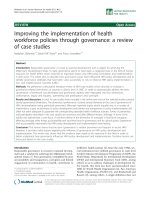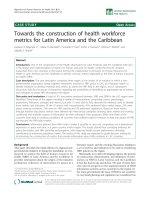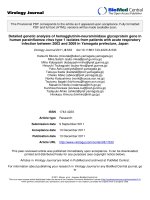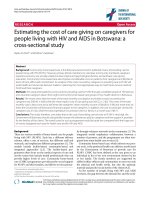Báo cáo sinh học: " Estimating the frequency of Asian cytochrome B haplotypes in standard European and local Spanish pig breeds" doc
Bạn đang xem bản rút gọn của tài liệu. Xem và tải ngay bản đầy đủ của tài liệu tại đây (69.1 KB, 8 trang )
Genet. Sel. Evol. 36 (2004) 97–104 97
c
INRA, EDP Sciences, 2004
DOI: 10.1051/gse:2003053
Original article
Estimating the frequency of Asian
cytochrome B haplotypes in standard
European and local Spanish pig breeds
Alex C
a
, Marcel A
a
,Jos
´
eLu
´
ıs N
b
,AnaF
´
c
,
Juan C
d
,MariaMiseric
`
ordia R
´
e
,Luc
´
ıa K
f
,
James M.H. K
g
,LeifA
g
,ArmandS
`
a∗
a
Departament de Ci`encia Animal i dels Aliments, Facultat de Veterin`aria,
Universitat Aut`onoma de Barcelona, Bellaterra 08193, Spain
b
Area de Producci´o Animal, Centre UdL-IRTA, Alcalde Rovira Roure 177,
Lleida 25198, Spain
c
Area de Gen´etica y Mejora Animal, SGIT-INIA, Ctra. De la Coru˜na km. 7,
Madrid 28040, Spain
d
Instituto Canario de Investigaciones Agrarias, Apartado de correos 60,
La Laguna 38200, Spain
e
Departament de Biologia, Laboratori de Gen`etica, Universitat de les Illes Balears,
Ctra. Valldemossa, km 7.5, Palma de Mallorca 07071, Spain
f
Departamento de Biolog´ıa Celular y Molecular, Facultad de Veterinaria, Universidad
de la Rep´ublica, Av. Lasplaces 1550, Montevideo, CP 11600, Uruguay
g
Department of Animal Breeding and Genetics, Swedish University of Agricultural Sciences,
Uppsala Biomedical Centre, 751 24, Uppsala, Sweden
(Received 20 December 2002; accepted 27 August 2003)
Abstract – Mitochondrial DNA has been widely used to perform phylogenetic studies in dif-
ferent animal species. In pigs, genetic variability at the cytochrome B gene and the D-loop
region has been used as a tool to dissect the genetic relationships between different breeds
and populations. In this work, we analysed four SNP at the cytochrome B gene to infer the
Asian (A1 and A2 haplotypes) or European (E1 and E2 haplotypes) origins of several Euro-
pean standard and local pig breeds. We found a mixture of Asian and European haplotypes in
the Canarian Black pig (E1, A1 and A2), German Pi´etrain (E1, A1 and A2), Belgian Pi´etrain
(E1, A1), Large White (E1 and A1) and Landrace (E1 and A1) breeds. In contrast, the Iberian
(Guadyerbas, Ervideira, Caldeira, Campanario, Puebla and Torbiscal strains) and the Majorcan
Black pig breeds only displayed the E1 haplotype. Our results show that the introgression of
Chinese pig breeds affected most of the major European standard breeds, which harbour Asian
haplotypes at diverse frequencies (15−56%). In contrast, isolated local Spanish breeds, such as
the Iberian and Majorcan Black pig, only display European cytochrome B haplotypes, a feature
∗
Corresponding author:
98 A. Clop et al.
that evidences that they were not crossed with other Chinese or European commercial popu-
lations. These findings illustrate how geographical confinement spared several local Spanish
breeds from the extensive introgression event that took place during the 18th and 19th centuries
in Europe.
mitochondria / cytochrome B / pig breeds / Asian and European haplotypes / introgression
1. INTRODUCTION
Pig mitochondrial DNA (mtDNA) is a 16 kb circular molecule including
13 protein-coding genes, 22 tRNA and genes responsible for 12S and 16S
rRNA [7, 15]. Phylogenetic analysis of the porcine mitochondrial genome
has revealed that Wild Boar subspecies were independently and simultane-
ously domesticated in Asia and Europe 9000 YBP [2, 6–8, 10]. Major Euro-
pean and Asian mtDNA clades diverged well before this domestication event
and the estimates for the time of divergence range from 58 000 to 900 000
YBP [1, 2, 6, 7, 10]. Two distinct European clades denoted E1 and E2 have
also been characterised by Giuffra and coworkers [2]. The former one has
been found in most of the European Wild Boars and domestic pig breeds,
whereas E2 has been detected in three Wild Boars from Italy. The major cy-
tochrome B (CytB) haplotypes can be easily distinguished on the basis of four
single nucleotide polymorphisms located at positions 15036, 15038, 15041 and
15045 bp of the complete sequence of the pig mtDNA (numbering of positions
follows Ursing and Arnason [17]).
In this paper, we analysed cytochrome B (CytB) haplotypes in the Iberian,
Majorcan Black and Canarian Black Spanish autochthonous breeds and several
European standard breeds such as the Large White, Landrace, and Pi´etrain.
Our main goal was to compare the prevalence of Asian haplotypes in three of
the major commercial European pig breeds with regards to three local Euro-
pean pig populations which have remained geographically isolated for a long
time span.
2. MATERIALS AND METHODS
2.1. Animal material
We analysed 82 samples from three autochthonous Spanish breeds including
the Majorcan Black pig (MB, n = 21), Canarian Black pig (CB, n = 11) and
Iberian (IB, n = 50). The IB samples belonged to the Torbiscal (n = 24),
Ervideira (n = 5), Caldeira (n = 5), Puebla (n = 5), Guadyerbas (n = 6)
and Campanario (n = 5) strains. Moreover, we typed CytB from 257 samples
corresponding to German Pi´etrain (GPI, n = 69), Belgian Pi´etrain (BPI, n =
33), Large White (LW, n = 43), and Landrace (LD, n = 112) breeds (Tab. I).
CytB haplotypes of standard and local pig breeds 99
Table I . Distribution of European (E1 = TGCG and E2 = TGTG ) and Asian (A1 =
CATA and A2 = CATG) haplotypes in several European standard and local pig breeds.
The Iberian samples belong to the Torbiscal (n = 24), Ervideira (n = 5), Caldeira
(n = 5), Puebla (n = 5), Guadyerbas (n = 6) and Campanario (n = 5) strains. The
SNP are located at position 15036 (T/C), 15038 (G/A), 15041 (C/T) and 15045 (G/A)
from the complete sequence of pig mtDNA [6], respectively.
Breed Haplotype Total
E1 E2 A1 A2
Iberian pig 50 0 0 0 50
Majorcan Black pig 21 0 0 0 21
Canarian Black pig 3 0 3 5 11
German Pi´etrain 40 0 2 27 69
Belgian Pi´etrain 28 0 5 0 33
Large White 19 0 24 0 43
Landrace 94 0 18 0 112
Total 255 0 52 32 339
The LW and LD pigs typed in this experiment belong to two different maternal
lines imported from France in 1980 and they have been selected for litter size,
backfat and growth performance. The GPI pigs were imported from Germany
and they have been selected for backfat and growth performance. The BPI pigs
belong to the original Pi´etrain purebred population originating in Belgium in
1920 and they have been used as a source of genetic material in a Belgian
artificial insemination centre [3].
2.2. Amplification of the CytB gene
Total DNA was extracted from 0.5 mL of whole blood using the DNA Iso-
lation Kit for Mammalian Blood (Roche Diagnostics S.L., Barcelona, Spain)
or a standard phenol-chloroform and ethanol precipitation method. Briefly,
white blood cells were repeatedly washed with 0.5 mL TE (Tris 10 mM, EDTA
1 mM, pH 8.0) and incubated in 0.4 mL lysis buffer (50 mM KCl, 10 mM Tris,
2.5 mM MgCl
2
, 0.5% Tween 20, pH 8.3) plus 10 µL proteinase K
(10 mg·mL
−1
)at56
◦
C for 4 h. Nucleic acids were purified by chlorophorm
extraction and precipitated with two volumes of ethanol. The DNA pellet was
washed with ethanol 70% and resuspended in ultrapure water. We amplified
a sequence of 131 bp of the CytB gene. This sequence contains four SNP lo-
cated at positions 47 (T/C), 49 (G/A), 52 (C/T) and 56 (G/A) bp of the PCR
product that correspond to positions 15036, 15038, 15041 and 15045 bp of
the pig mtDNA. The E1 (TGCG) and the E2 (TGTG) haplotypes are Euro-
pean, whereas the A1 (CATA) and the A2 (CATG) haplotypes have an Asian
origin [2, 5]. The amplification of the target region was performed in a final
100 A. Clop et al.
volume of 20 µL containing 50 mM KCl, 15 mM Tris-HCl at pH 8.0, 1.5 mM
MgCl
2
, 200 µMdNTP,0.5µM of the forward primer (FW: 5’-CGC CTA CGC
TAT TCT ACG TTC A-3’), 0.5 µM of the reverse primer (REV: 5’-GTG GTC
GAA ATA TTA TGC CTC GTT-3’), 0.5 U of AmpliTaq Gold DNA poly-
merase (Applied Biosystems, Foster City, CA, USA) and 2 ng of genomic
DNA. After denaturation at 95
◦
C for 10 min, the reactions were heated for
30 cycles at 94
◦
C for 30 s, 54
◦
C for 30 s and 72
◦
C for 30 s.
2.3. Sequencing of the PCR product
Amplified products were purified with the QIAquick PCR Purification kit
(Qiagen, Servicios Hospitalarios, Barcelona, Spain). The purified PCR re-
action was analysed by using either pyrosequencing [13] or a conventional
Sanger dideoxy sequencing method [14]. Five IB pigs, five MB pigs and all the
LW, LD and GPI pigs were analysed by pyrosequencing, whereas the remain-
ing individuals were typed by conventional sequencing. We used the BigDye
Terminator Cycle Sequencing v2.0 Ready Reaction kit (Applied Biosystems)
and the reverse primer to perform Sanger dideoxy sequencing. The thermal
profile was 94
◦
C for 3 min, followed by 25 cycles of 94
◦
C for 10 s, 50
◦
C
for 5 s and 60
◦
C for 4 min. Pyrosequencing was performed with the Luc96
TM
SNP Reagent Kit (Pyrosequencing AB, Uppsala, Sweden) according to the in-
structions of the manufacturer. The final volume of the reaction was 40 µL
containing 20 mM Tris-Acetate, 5 mM MgCl
2
, 15 pmol of the pyrosequencing
primer PYR, 5’-GATTAGGATGGAGGCT-3’ and the PCR fragment immo-
bilised with M-280 streptavidin dynabeads (Dynal AS, Oslo, Norway).
3. RESULTS AND DISCUSSION
The prevalence of cytB and D-loop European and Asian haplotypes had
been previously studied in major European commercial breeds such as the
Large White, Landrace, Duroc, Hampshire and others [2, 7, 10]. These studies
demonstrate that most of these standard breeds had been extensively intro-
gressed with Asian alleles. However, to the best of the authors knowledge
there is not any estimate of the frequency of Asian haplotypes in local breeds
with a limited geographical distribution and that have been selected for produc-
tive goals mostly related to the manufacture of specialised and highly-priced
products.
Partial sequencing of the cytB gene in standard breeds demonstrated the
presence of Asian cytB haplotypes in LW and LD (Tab. I). There is am-
ple historical evidence indicating that many Chinese pigs were imported into
England from 1770 to 1860 and introgressed into the English populations
CytB haplotypes of standard and local pig breeds 101
which influenced the development of the LW, Berkshire, Small White and Mid-
dle White breeds [5]. The main objective of this introgression was to accelerate
fattening and achieve an earlier maturity [5]. Similarly, there are abundant his-
torical records suggesting that the LD breed was produced by crossing British
and Chinese breeds with native land pig populations during the 18th and 19th
centuries. Our estimate of the prevalence of Asian haplotypes in LW and LD
was quite consistent with the data reported by Giuffra [2] and coworkers and
suggests that LD was affected to a lesser extent than LW by the introgression
of Asian alleles. This conclusion is supported by the phylogenetic analysis of
D-loop sequences of several European and Asian breeds, which demonstrated
that LW D-loop sequences clustered with their Asian orthologs but not with
the European ones [7].
We have also analysed for the first time the prevalence of cytB haplotypes
in the BPI and GPI breeds. The BPI breed originated around the small vil-
lage of Pi´etrain in Belgium in 1920, but its ancestry still remains obscure [5].
Several authors suggest that the BPI breed was likely produced by the mixture
of local Belgian breeds and other European populations such as the Berkshire,
LW, Bayeux of Normandy, P´erigord and Tamworth [5]. CytB genotyping of 33
BPI pigs demonstrated that the A1 haplotype has a frequency of 15% (Tab. I).
This finding is consistent with the participation of LW, and other introgressed
breeds, in the foundation of BPI. In contrast, GPI pigs displayed a high fre-
quency of the A2 haplotype (39%, Tab. I), which is a minority in other breeds.
GPI is a composite breed resulting from the mixture of BPI, Belgian LD and
other genetic backgrounds in order to increase the small body size and poor
daily gain that characterises BPI pigs [11]. Likely, the A2 haplotype was in-
troduced in the GPI population not through BPI but by the means of any of the
other breeds that participated in its foundation.
The study of the cytB haplotype distribution in three Spanish breeds pro-
vided an interesting perspective of how the introgression of Chinese breeds
that took place in Europe in the 18th and 19th centuries influenced local and
isolated populations. We found that Asian cytB haplotypes are completely ab-
sent from the IB and MB breeds, whereas the CB breed shows an extremely
high prevalence of the A2 haplotype (73%, Tab. I). The particular historical
events that resulted in the foundation of the IB and MB breeds and their geo-
graphical isolation may explain why we did not find any Asian cytB haplotype
in these two populations. Iberian is the main Spanish pig breed due to the eco-
nomic importance of its cured products and its population census. Iberian pigs
are reared in the south-west of Spain and they are typically fat and black or
red coloured or even black spotted, depending on their origin. The Torbiscal
IB strain was generated in 1963 from four different crosses involving Negro
102 A. Clop et al.
Lampi˜no, Retinto and Dourado Alentejano IB pigs [1, 16], whereas Guadyer-
bas is a highly inbred strain that was derived from a small number of Negro
Lampi˜no pigs in 1945 [15]. Other IB strains are Puebla, Campanario, Ervideira
and Caldeira, the two latter ones originating from Portugal. In this way, these
IB strains have emerged as a result of the mixture of ancestral autochthonous
pig populations from the Iberian Peninsula. They have not been significantly
introgressed with other Chinese or European breeds, probably due to the fact
that IB pigs remained geographically isolated for a long time span. Our results
were in good agreement with the cytB typing of IB pigs by Alves et al. [1]
clearly demonstrating the absence of Asian cytB haplotypes in these Spanish
autochthonous pig populations. Similarly, we did not find any evidence of in-
trogression of Chinese breeds in the MB breed, which was described by the
first time in the Majorca Island in the 19th century. MB pigs are black coated,
lop-eared and extremely fat, and they have wattles in the neck. The origin of
the MB breed is unclear but there is archaeological evidence suggesting the
presence of pigs in Majorca as early as the 14th century B.C. [9]. These pigs
were probably brought by the Phoenician colonisers being mixed with other
swine breeds due to the invasion of the Balearic Islands by the Romans, and
the Catalans [4, 9]. The small effective size of this breed, the geographical
confinement and the strong influence of Iberian black pigs on its development
might explain the complete absence of Asian haplotypes in this breed.
The only Spanish breed that displayed Asian haplotypes was CB, which is a
black pre-Hispanic breed that is exclusively found on the Canary Islands. The
origin of this breed is still a matter of debate. According to Robert et al. [12],
the first settlers of the Canary Islands came from North Africa at the end of the
third millennium B.C. This indigenous civilisation used pig derived products
as a source of food and for clothing. The occurrence of multiple colonisation
events and the conquest of the Canary archipelago by Spain in the 15th century
favoured the emergence of the CB breed from the mixture of Spanish, British
and North African genetic backgrounds. Two hypotheses might explain the
frequent presence of the A2 haplotype in CB. First, it is possible that this A2
haplotype was introduced in the CB breed due to the introgression of British
breeds harbouring this particular haplotype. Conversely, it is possible that the
A2 haplotype was present in the ancestral North African pig population that
was brought by the first settlers of the Canary Islands. In fact, the CB breed
shows several morphological traits, such as the presence of wrinkles in the
skin and large ears over the eyes, that are distinctive of the Chinese breeds.
Taken together, our results demonstrate that Asian haplotypes are ubiquitously
distributed in most of the standard European pig breeds but not in local popu-
lations that have remained geographically isolated. As the next step, it would
be interesting to type the cytB gene in African pig breeds to investigate from
CytB haplotypes of standard and local pig breeds 103
which of the two Asian and European domestication centers they originate and
to dissect the complex mixture of forces and historical circumstances that have
influenced pig domestication worldwide.
ACKNOWLEDGEMENTS
We are grateful to J. Caraballo and M. Castro for providing Canarian Black
pig blood samples and to M. Georges and L. Moreau for extracting and pro-
viding total DNA from Belgian Pi´etrain blood samples. Thanks to A. Tejera
Gaspar for helpful discussion and to G. Nyman for her contribution in the py-
rosequencing work. We are also indebted to J.A. Castro and A. Picornell for
technical assistance. Thanks to SIA “El Deheson del Encinar” (Toledo, Spain)
and to COPAGA and Nova Gen`etica for providing Iberian, German Pi´etrain,
Large White and Landrace blood samples. Alex Clop received a predoctoral
fellowship from the Universitat Aut`onoma de Barcelona.
REFERENCES
[1] Alves E.,
´
Ovilo C., Rodr´ıguez C., Sili´o L., Mitochondrial DNA sequence varia-
tion and phylogenetic relationships among Iberian pigs and other domestic and
wild pig populations, Anim. Genet. 34 (2003) 319–324.
[2] Giuffra E., Kijas J.M., Amarger V., Carlborg O., Jeon J.T., Andersson L., The
origin of the domestic pig: independent domestication and subsequent introgres-
sion, Genetics 154 (2000) 1785–1791.
[3] Hanset R., Dasnois C., Scalais S., Michaux C., Grobet L., Effet de l’introgression
dans le g´enome Pi´etrain de l’all`ele normal au locus de sensibilit´e`a l’halothane,
Genet. Sel. Evol. 27 (1995) 77–88.
[4] Jaume J., Picornell A., Ghio G., Castro J.A., Ram´on M.M., El porc negre mal-
lorqu´ı. La gen`etica com a eina per la recuperaci´o d’una rac¸a aut`octona, Revista
de Ci`encia (IEB) 21 (1997) 105–117.
[5] Jones G.F., Genetic aspects of domestication, common breeds and their origin,
in: Rothschild M.F., Ruvinsky A. (Eds.), The Genetics of the Pig, CAB Interna-
tional, Wellingford, Oxon, UK, 1998, pp. 17–50.
[6] Kijas J.M., Andersson L., A phylogenetic study of the origin of the domestic
pig estimated from the near-complete mtDNA genome, J. Mol. Evol. 52 (2001)
302–308.
[7] Kim K.I., Lee J.H., Li K., Zhang Y.P., Lee S.S., Gongora J., Moran C., Phyloge-
netic relationships of Asian and European pig breeds determined by mitochon-
drial DNA D-loop sequence polymorphism, Anim. Genet. 33 (2002) 19–25.
[8] Lin C.S., Sun Y.L., Liu C.Y., Yang P.C., Chang L.C., Cheng I.C., Mao S.J.,
Huang M.C., Complete nucleotide sequence of pig (Sus scrofa) mitochon-
drial genome and dating evolutionary divergence within Artiodactyla, Gene 236
(1999) 107–114.
104 A. Clop et al.
[9] Mora J., Palou M., Sobrassada de Porc Negre, Govern Balear, Conselleria
d’Agricultura i Pesca (1993).
[10] Okumura N., Kurosawa Y., Kobayashi E., Watanobe T., Ishiguro N., Yasue H.,
Mitsuhashi T., Genetic relationship amongst the major non-coding regions of
mitochondrial DNAs in wild boars and several breeds of domesticated pigs,
Anim. Genet. 32 (2001) 139–147.
[11] Porter V., Pigs: A Handbook to the Breeds of the World, Cornell University,
Ithaca, New York, 1993.
[12] Robert A., Zamorano M.J., Gin´es R., Arg¨uello A., Delgado J.V., L´opez J.L., Ori-
gen y estado actual del Cerdo Negro Canario, Arch. Zootec. 49 (2000) 291–296.
[13] Ronagui M.,
´
Uhlen M., Nyr´en P., Real-time pyrophosphate detection for DNA
sequencing, Science 281 (1998) 363–364.
[14] Sanger F., Nicklen S., Coulson A.D., DNA sequencing with chain-terminating
inhibitors, Proc. Natl. Acad. Sci. USA 74 (1977) 5463–5467.
[15] Toro M.A., Rodrig´a˜nez J., Sili´o L., Rodr´ıguez M.C., Genealogical analysis of a
closed herd of black hairless Iberian pigs, Cons. Biol. 14 (2000) 1843–1851.
[16] Toro M., Barrag´an C.,
´
Ovilo C., Rodrig´a˜nez J., Rodr´ıguez C., Sili´o L., Esti-
mation of coancestry in Iberian pigs using molecular markers, Cons. Genet. 3
(2002) 309–320.
[17] Ursing B.M., Arnason U., The complete mitochondrial DNA sequence of the pig
(Sus scrofa), J. Mol. Evol. 47 (1998) 302–306.
To access this journal online:
www.edpsciences.org









